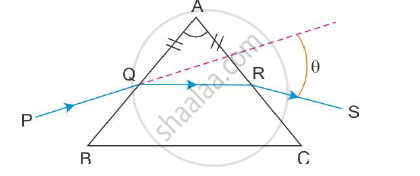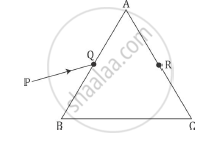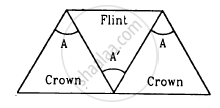Advertisements
Advertisements
प्रश्न
A thin prism of crown glass (μr = 1.515, μv = 1.525) and a thin prism of flint glass (μr = 1.612, μv = 1.632) are placed in contact with each other. Their refracting angles are 5.0° each and are similarly directed. Calculate the angular dispersion produced by the combination.
उत्तर

For crown glass, we have:-
Refractive index for red colour, μcr = 1.515
Refractive index for violet colour, μcv = 1.525
For flint glass, we have:-
Refractive index for red colour, μfr = 1.612
Refractive index for violet colour,μfv = 1.632
Refracting angle, A = 5°
Let:-
δc = Angle of deviation for crown glass
δf = Angle of deviation for flint glass
As prisms are similarly directed and placed in contact with each other, the total deviation produced (δ) is given by
δ = δc + δf
= (μc - 1)A + (μf – 1)A
= (μc + μf – 2)A
For violet light, δv = (μcv + μfv – 2)A
For red light, δr = (μcr + μfr – 2)A
Now, we have:-
Angular dispersion of the combination:-
δv – δr = (μcv + μfv – 2)A – (μcr + μfr – 2)A
= (μcv + μfv – μcr – μfr) A
= (1.525 + 1.632 – 1.515 – 1.612)5
= 0.15°
So, the angular dispersion produced by the combination is 0.15°.
APPEARS IN
संबंधित प्रश्न
A ray PQ incident on the refracting face BA is refracted in the prism BAC as shown in the figure and emerges from the other refracting face AC as RS such that AQ = AR. If the angle of prism A = 60° and refractive index of material of prism is `sqrt3 `. Calculate angle θ.

A ray PQ incident on the face AB of a prism ABC, as shown in the figure, emerges from the face AC such that AQ = AR.

Draw the ray diagram showing the passage of the ray through the prism. If the angle of the prism is 60° and refractive index of the material of prism is `sqrt3` , determine the values of angle of incidence and angle of deviation
What is a dispersion of light
A ray of light incident normally on one face of a right isosceles prism is totally reflected, as shown in fig. What must be the minimum value of refractive index of glass? Give relevant calculations.

State any two difference between the primary rainbow and secondary rainbow
The equation \[\omega = \frac{\mu_u - \mu_r}{\mu - 1}\] was derived for a prism having small refracting angle. Is it also valid for a prism of large refracting angle? Is it also valid for a glass slab or a glass sphere?
Can the dispersive power \[\omega = \frac{\mu_u - \mu_r}{\mu - 1}\] be negative? What is the sign of ω if a hollow prism is immersed into water?
If three identical prisms are combined, is it possible to pass a beam that emerges undeviated? Undispersed?
The angular dispersion produced by a prism ___________ .
A certain material has refractive indices 1.56, 1.60 and 1.68 rfor red, yellow and violet lightespectively. (a) Calculate the dispersive power. (b) Find the angular dispersion produced by a thin prism of angle 6° made of this material.
Three thin prisms are combined as shown in figure. The refractive indices of the crown glass for red, yellow and violet rays are μr, μy and μv respectively and those for the flint glass are μ'r, μ'y and μ'v respectively. Find the ratio A'/A for which (a) there is no net angular dispersion, and (b) there is no net deviation in the yellow ray.

The refractive index of a material M1 changes by 0.014 and that of another material M2 changes by 0.024 as the colour of the light is changed from red to violet. Two thin prisms, one made of M1(A = 5.3°) and the other made of M2(A = 3.7°) are combined with their refracting angles oppositely directed. (a) Find the angular dispersion produced by the combination. (b) The prisms are now combined with their refracting angles similarly directed. Find the angular dispersion produced by the combination.
An equilateral glass prism has a refractive index 1.6 in the air. Calculate the angle of minimum deviation of the prism, when kept in a medium of refractive index `4sqrt(2)"/"5.`
How does the angle of minimum deviation of a glass prism vary if the incident violet light is replaced by red light?
Define angular dispersion.
When a ray of white light is incident obliquely on the first surface of a prism, then ______.
